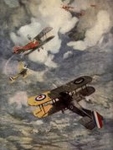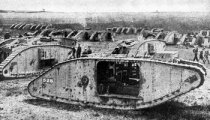
Worksheets and No Prep Teaching Resources
Reading Comprehension Worksheets
World War I

World War I
 Worksheets and No Prep Teaching Resources Reading Comprehension Worksheets World War I |
 World War I |
| edHelper's suggested reading level: | grades 4 to 6 | |
| Flesch-Kincaid grade level: | 5.28 |
|
Thanks for the Tanks
By Jane Runyon |

|
 1 There were no tanks used in war before World War I. After all, motorized vehicles had not been invented that long ago. Up until 1916, if an army wanted to protect one of its vehicles, they would take pieces of reinforced steel and place them on the vehicle to keep bullets from penetrating them. In other words, they tried to make a bullet proof car. This plan worked, up to a point. The armored cars could only travel on cleared roads. If any fighting was taking place off the road, the cars could not reach the action. All this changed on September 15, 1916. It was at this time that the British introduced tanks to battle.
1 There were no tanks used in war before World War I. After all, motorized vehicles had not been invented that long ago. Up until 1916, if an army wanted to protect one of its vehicles, they would take pieces of reinforced steel and place them on the vehicle to keep bullets from penetrating them. In other words, they tried to make a bullet proof car. This plan worked, up to a point. The armored cars could only travel on cleared roads. If any fighting was taking place off the road, the cars could not reach the action. All this changed on September 15, 1916. It was at this time that the British introduced tanks to battle. |
Create Weekly Reading Books
Prepare for an entire week at once! |
| Leave your feedback on Thanks for the Tanks (use this link if you found an error in the story) |
 |
World War I
|
 |
Social Studies
|
 |
United States
|
|
|
|
|
 | Fifty States Theme Unit |
 |
Document Based Activities |